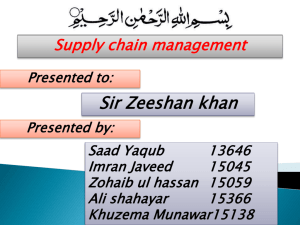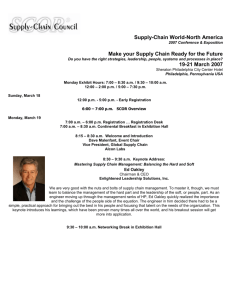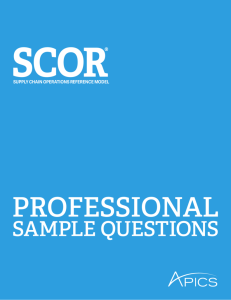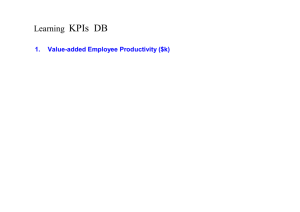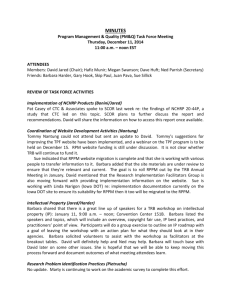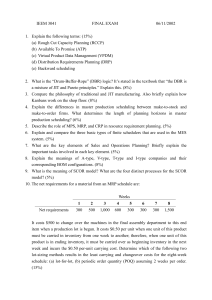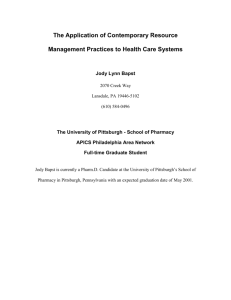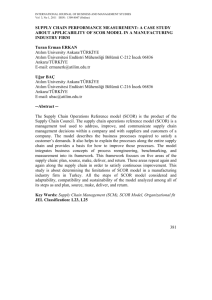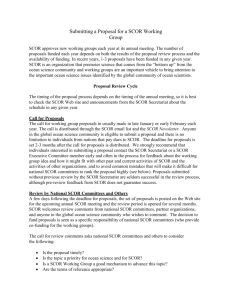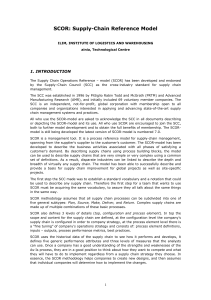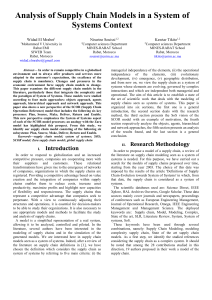Presentation Outline
advertisement
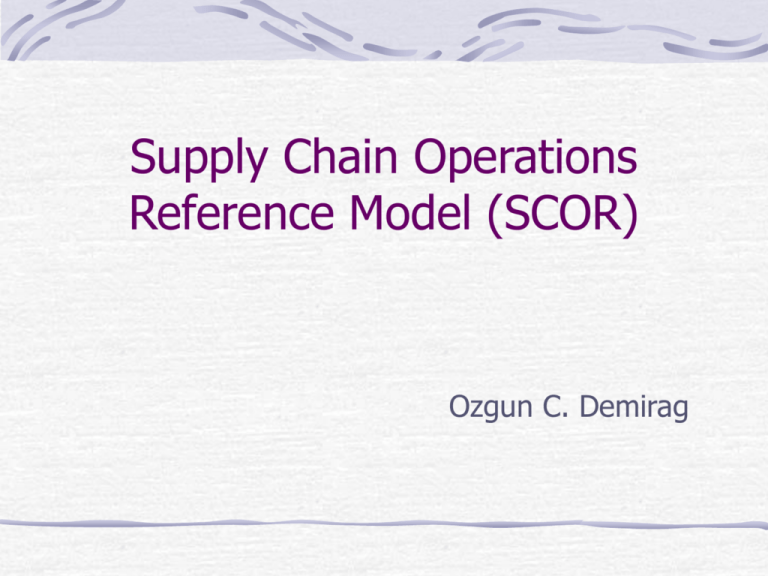
Supply Chain Operations Reference Model (SCOR) Ozgun C. Demirag Supply Chain Operations Reference Model (SCOR): Information about (SCC) Developed by Supply Chain Council (SCC) SCC: Independent, not-for-profit corporation organized in 1996 by: Global management-consulting firm, Pittiglio Rabin Todd & McGrath (PRTM) and Market research firm, Advanced Manufacturing Research (AMR) in Cambridge, Massachusetts. Started with 69 voluntary companies; now close to 1000 members. SCC Objective: To develop a standard supply-chain process reference model enabling effective communication among the supply chain partners, by Using standard terminology to better communicate and learn the supply chain issues Using standard metrics to compare and measure their performances Supply Chain Operations Reference Model (SCOR) SCOR: Integrates Business Process Reengineering, Benchmarking, and Process Measurement into a cross-functional framework. Capture the “as-is” state of a process and derive the desired “to-be” future state Business Process Reengineering Capture the “as-is” state of a process and derive the desired “to-be” future state Quantify the operational performance of similar companies and establish internal targets based on “best-inclass” results Benchmarking Characterize the management practices and software solutions that result in “bestin-class” performance Best Practices Analysis Quantify the operational performance of similar companies and establish internal targets based on “best-in-class” results Characterize the management practices and software solutions that result in “best-inclass” performance Process Reference Model Supply Chain Operations Reference Model (SCOR) The Primary Use of SCOR: To describe, measure and evaluate supply chain configurations. SCOR contains: Standard descriptions of management processes A framework of relationships among the standard processes Standard metrics to measure process performance Management practices that produce best-in-class performance Enables the companies to: Evaluate and compare their performances with other companies effectively Identify and pursue specific competitive advantages Identify software tools best suited to their specific process requirements Supply Chain Operations Reference Model (SCOR): Boundaries SCOR spans: • All customer interactions, from order entry through paid invoice. • All product (physical material and service) transactions, from supplier’s supplier to customer’s customer, including equipment, supplies, spare parts, bulk product, software, etc. • All market interactions, from the understanding of aggregate demand to the fulfillment of each order SCOR does not attempt to describe every business process or activity, including: • Sales and marketing (demand generation) • Research and technology development • Product development • Some elements of post-delivery customer support Supply Chain Operations Reference Model (SCOR):Basic Management Processes Plan-Source-Make-Deliver-Return Plan Deliver Supplier’s Supplier Source Return Make Deliver Return Supplier (Internal or External) Source Make Return Deliver Return Your Company Source Return Make Deliver Source Return Customer (Internal or External) Customer’s Customer Plan-Source-Make-Deliver-Return provide the organizational structure of the SCOR-model Scopes of Basic Management Processes Plan (Processes that balance aggregate demand and supply to develop a course of action which best meets sourcing, production and delivery requirements) Balance resources with requirements Establish/communicate plans for the whole supply chain Source (Processes that procure goods and services to meet planned or actual demand) Schedule deliveries (receive, verify, transfer) Make (Processes that transform product to a finished state to meet planned or actual demand) Schedule production Deliver (Processes that provide finished goods and services to meet planned or actual demand, typically including order management, transportation management, and distribution management) Warehouse management from receiving and picking product to load and ship product. Return (Processes associated with returning or receiving returned products) Manage Return business rules Three Levels of Process Detail Level # Description Supply Chain Operations Reference Model 1 Top Level (Process Types) Plan Source Return Make Deliver A company’s supply chain can be “configuredto-order” at Level 2 from the core “process categories.” Companies implement their operations strategy through the configuration they choose for their supply chain. Configuration Level (Process Categories) 3 Process Element Level (Decompose Processes) P1.1 Identify, Prioritize, and Aggregate Supply-Chain Requirements P1.2 Identify, Assess, and Aggregate Supply-Chain Requirements Implementation Level (Decompose Process Elements) Level 1 defines the scope and content for the Supply chain Operations Reference-model. Here basis of competition performance targets are set. Return 2 4 Not in Scope Comments Schematic P1.3 P1.4 Balance Production Resources with Supply-Chain Requirements Establish and Communicate Supply-Chain Plans Level 3 defines a company’s ability to compete successfully in its chosen markets, and consists of: Process element definitions Process element information inputs, and outputs Process performance metrics Best practices, where applicable System capabilities required to support best practices Systems/tools Companies implement specific supply-chain management practices at this level. Level 4 defines practices to achieve competitive advantage and to adapt to changing business conditions. Level 1 Performance Metrics Customer-Facing Supply Chain Reliability Responsiveness Internal-Facing Flexibility Cost Assets Performance Attributes Delivery performance Fill rate Perfect order fulfillment Order fulfillment lead time Supply Chain Response Time Production flexibility Total SCM cost Cost of Goods Sold Value-added productivity Warranty cost or returns processing cost Cash-to-cash cycle time Inventory days of supply Asset turns Level Metrics Facts Level 1 Metrics are primary, high level measures that may cross multiple SCOR processes. They do not necessarily relate to a SCOR Level 1 process (Plan-SourceMake-Deliver-Return). There is hierarchy among the metrics in different levels. Level 1 Metrics are created from lower level calculations (Level 2 metrics) Level 2 Metrics: Associated with a narrower subset of processes. Example: Metric related with Delivery Performance: Total number of products delivered on time and in full based on a commit date. Metric related with Production: Ratio Of Actual To Theoretical Cycle Time Level 2 Process Types and Definitions Planning: A process that aligns expected resources to meet expected demand requirements. Balance aggregated demand and supply Consider consistent planning horizon (Generally) occur at regular, periodic intervals Execution: A process triggered by planned or actual demand that changes the state of material goods. Scheduling/sequencing Transforming product Moving product to the next process Enable: A process that prepares, maintains, or manages information or relationships on which planning and execution processes rely P1: Plan Supply Chain P2-P5: Plan SCOR Process S1: Source Stocked Product S3: Source Engineer-to-Order Product S2: Source Make-to-Order Product M1: Make-to-Stock M2: Make-to-Order M3: Engineer-to-Order D1: Deliver Stocked Product D2: Deliver Make-to-Order Product D3: Deliver Engineer-to-Order Product D4: Deliver Retail Product (New in Version 6.0) SR1/DR1: Return Defective Product (Source Return/Deliver Return) SR2: Source Return MRO Product (Maintenance, Repair and Overhaul) DR2: Deliver Return MRO Product SR3/DR3: Return Excess Product (Source Return/Deliver Return) EP, ES, EM, ED, ER: Enable corresponding SCOR Processes Level 2 Process Categories Example Continued Process Number: S1 Process Category: Source Stocked Product Process Category Definition The procurement, delivery, receipt and transfer of raw material items, subassemblies, product and or services. Performance Attributes Metric Reliability % Orders/lines processed complete Responsiveness Total Source Cycle Time to Completion Flexibility Time and Cost related to Expediting the Sourcing Processes of Procurement, Delivery, Receiving and Transfer. Cost Product Acquisition Costs Assets Inventory DOS Best Practices Features Joint Service Agreements Alliance and Leverage agreements None Identified Example Continued Process Element Number: S1.4 Process Element: Transfer Product Process Element Definition The transfer of accepted product to the appropriate stocking location within the supply chain. This includes all of the activities associated with repackaging, staging, transferring and stocking product. For service this is the transfer or application of service to the final customer or end user. Performance Attributes Metric Reliability % Product transferred damage free % Product transferred complete % Product transferred on-time to demand requirement % Product transferred without transaction errors Responsiveness Transfer Cycle Time Flexibility Time and Cost Reduction related to Expediting the Transfer Process. Cost Transfer & Product storage costs as a % of Product Acquisition Costs Assets Inventory DOS Best Practices Features Drive deliveries directly to stock or point-ofuse in manufacturing to reduce costs and cycle time Pay on receipt Specify delivery location and time (to the minute) Specify delivery sequence Capability Transfer to Organization None Identified Example Continued Inputs Plan Source Product Pull Signals Product Inventory Location Make Deliver M D ES.4 WIP Inventory Location EM ED Finished Goods Inventory Location Outputs Plan Source Make Deliver Inventory Availability P2.2 ES.4 M1.2, M2.2, M3.3 D1.8, D4.2 Daily Replenishment Requirements D4.1 Loaded Cart D4.4 Some Graphical Tools: 1st Step in configuring a SC: Illustrate physical layout, material flow and place Level 2 execution process categories to describe activities at each location. SCOR Process Maps 2nd Step: Create the SCOR Process Maps: Place planning process categories, using dashed lines to show links with execution processes Software Package for Modeling SCOR: ARIS EasySCOR The ARIS Toolset and ARIS Easy Design are process modeling tools. The ARIS Toolset is a BPR tool, Easy Design is used for process capture. The EasySCOR Modeler is a software package that includes the ARIS Easy Design modeling kit and the SCOR model in ARIS format. ARIS EasySCOR consists of process models that describe the SCOR levels 1 to 3. Implementation level, level 4 is not included. Process Map Example created in ARIS EasySCOR Suppliers Supplier Suppliers Assemble/ Package Distribution Centers Americas---> Europe---> Asia---> Geo Ports of Entry Observations SCOR describes processes not functions. In other words, the Model focuses on the activity involved, not the person or organizational element that performs the activity. Implementation level, Level 4, is not described in SCOR. References SCOR 6.0 Overview Booklet http://www.isye.gatech.edu/~lfm/8851/Sources/SCOR/SCOR%206.0% 20OverviewBooklet.pdf Supply-Chain Operations Reference-model (SCOR) 6.0 Introduction (in setup files) About ARIS: http://www.changeware.net/esitteet/scor-faq.pdf About ARIS: http://www.changeware.net/esitteet/scor-faq.pdf
